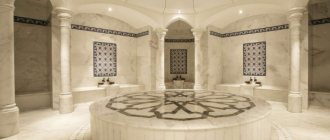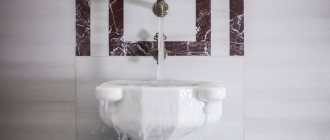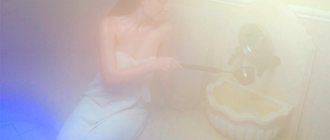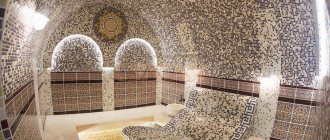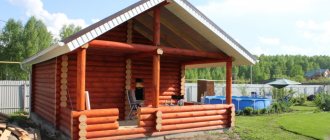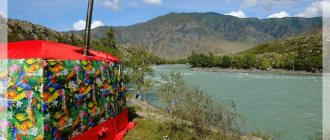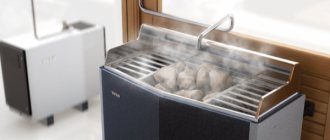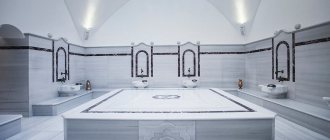- Sento device
- At the spa
- Traditional
- Device
In addition to the traditional wet Russian bath, the usual dry-air Finnish sauna and the newfangled Turkish hammam, which have become widespread in our country, there are many different types of steam rooms. Almost every nationality has its own kind of baths. Each of them has its own characteristics and secrets. You can endlessly consider all types of baths and their specifics, because some nations even have several of them. For example, among Japanese steam rooms there are three types: sento, ofuro and furako. We will look at the most interesting types of pairs.
Egyptian mud bath rasul
The rasul bath comes from ancient Egypt. It is known that the pharaohs themselves were her fans. This is an exotic and powerful water-steam procedure. In addition to warming up, it includes wrapping the body with healing mud, sand, herbal and algae extracts, and clay.
Rasul has a positive effect on the skin - it rejuvenates and cleanses it. In addition, healing substances freely penetrate through heated skin to the internal organs, saturating them and healing them.
Rasul mud baths are famous for their complex design. Traditionally they have two floors. On the first floor there is a technical area - powerful steam generators are located here. Part of the steam is supplied through a special hole to the second floor directly into the steam room. The other part is distributed among niches in the walls and floor of the second floor. Thus, the room is heated, and the temperature is always the same.
There are visitors on the second floor. Here, in addition to the steam room, there is a pool with cold water, as well as heated marble loungers for massage.
A session in the Rasul bathhouse begins with the visitor having to thoroughly wash and dry himself. After this, you should go to a wet steam room. The temperature here is low - only about +40 degrees, but the humidity reaches 80%. After the body is well steamed, it is treated with mud compounds on the sun loungers. Beneficial substances should remain on the skin for about 15 minutes. After this, the visitor leaves the steam room and goes under a tropical shower. Finally, softening and antiseptic oils are applied to the body.
This procedure has a beneficial effect not only on the skin, but also on the internal organs and psycho-emotional state.
Cleanliness is the key to meeting the gods
The cleanliness and aesthetic views of the Egyptians reached the point of pedantry. Leaving the house without bracelets and a carefully styled hairstyle was the height of shamelessness. Jewelry sparkled in her hair and contained incense. For a resident of Ancient Egypt, cleanliness and health of the body were a reflection of inner perfection, bringing one closer to the gods. According to Herodotus, temple servants performed daily ablutions four times - at midnight, in the morning, at noon and in the evening. Is it any wonder that the Egyptians created the perfect bathhouse?
Egyptian sand bath
Its beneficial properties were known back in Ancient Egypt. According to the ancient Roman and Greek healers Pliny, Galen, Caelius and Herodotus, the sand steam room has a beneficial effect on human blood vessels and helps remove fat deposits.
Vertical sand bath
The essence of the procedures is as follows:
- We dig a hole in the sand the size of a person and, if necessary, clean it of large debris, algae, and stones. The sand used is fine and uniform.
- Let the sand in the pit warm up well in the sun. It should be hot at the bottom and walls.
- A person stands in this depression. We fill it with sand up to neck level.
- Cover the vacationer's head with a dry towel or umbrella to prevent heat stroke.
The duration of such a session ranges from five to twenty minutes.
Depending on the goals pursued and personal wishes, the sand bath provides additional procedures:
- During the session, a person is given watermelon to provoke increased sweating. This is recommended for people suffering from kidney stones.
- After the procedures, the vacationer wraps himself in a dry towel and drinks tea or broth to restore water balance.
- After the bath, a person bathes in sea or fresh water.
When the body is in the sand, it warms up evenly. The sweat released is also absorbed into the sand equally in all areas. Because of this, the vacationer does not feel discomfort, as with temperature changes.
Horizontal sand bath
Please note that visiting such a bathhouse has its contraindications.
These include anemia, general exhaustion and pneumonia. You can organize a kind of “steam room” as follows:
- We dig a pit 0.3-0.4 meters deep, its width and length depend on the height and weight of the vacationer.
- We leave it to warm up in the sun to +60-70 degrees.
- A man lies down in a hole. We fill it with sand to a level of 10-12 cm. At the same time, the layer of sand on the stomach should not exceed 3 cm, and leave the heart area open.
- Wrap your head in a damp towel or place an umbrella.
Session duration is up to 40 minutes.
After the procedures, you need to rest in the shade for 15-20 minutes and then take a shower. The main advantage of this type of steam room is that you can easily build a sand bath with your own hands. To do this, simply go to a beach with fine sand closer to noon, when the air temperature is high enough to warm up the hole to the required depth. If it is not possible to get to the beach, then you can use this service in spa salons.
A sand bath is an excellent alternative for people with fungal diseases for whom visiting a traditional steam room is not recommended.
Egyptian style during the Renaissance
During the Renaissance, attention was also often paid to ancient Egyptian art. The most obvious examples are the remains of Roman obelisks, which were destroyed during the Middle Ages.
During these times, these elements were returned to European architecture. In the 16th century, the Italian painter Giulio Clovio completed a series of miniatures called the Column Book, which was intended for Cardinal Pompeo Colonna and included obvious Egyptian decorative elements.
But only visual motifs were not enough; intellectual comprehension also went on at the same time. A serious contribution was made by humanists, who at that time were actively studying ancient texts. Diodorus describing the wonders of Egypt was translated. In 1419, one of Horapollo's manuscripts was found, containing a number of erroneous opinions about the translation of Egyptian hieroglyphs.
The text and drawings of Horapollo's Hieroglyphics, as well as other symbols copied from the ancient Roman temple at San Lorenzo, were used in the novel Hypnerotomachy of Polyphilus, written in 1499. This novel was extremely popular even several centuries after its publication and greatly influenced some works of art.
Note 1
An important role in the popularization of Egypt in Europe was played by the fact that representatives of humanism derived from ancient texts the idea that the Seven Great Sages of Antiquity were students of Egyptian priests (for example, Pythagoras).
Czech beer sauna
This innovation appeared in the Czech Republic about 9 years ago in the Chodovar brewery.
They say that visiting a beer steam room saturates the body with beneficial vitamins (beer contains a lot of vitamin B), and removes waste and toxins. The skin after this procedure is smooth and soft. The effect is noticeable for several weeks. According to some reports, bathing in beer can even protect a person from the evil eye. The essence of a beer bath is to heat the drink and mineral water in equal parts to a temperature of +37 degrees and fill the bath, which is traditionally presented in the form of an oak barrel. The duration of the session should not exceed 30 minutes. After the procedures, you need to wrap yourself up and sleep. It is not recommended to wash in water immediately.
Contraindications to visiting the beer steam room: changes in blood pressure, vascular inflammation, pregnancy, age under 12 years. It is undesirable to abuse alcoholic drinks while taking a bath.
Japanese sento bath
The Japanese sacredly honor their traditions, and therefore today, like several centuries ago, they arrange their bathhouse in accordance with all ancient rules. The building of a Japanese sento resembles a Shinto shrine. A blue curtain with the hieroglyph “boiling water” is hung at the entrance.
Construction of a Japanese bath
Features of this type of Japanese bath:
- After entering the bathhouse, there is a section for removing shoes. It is common for men and women.
- From it, two different entrances lead to two separate rooms (datsuiba) - men's and women's, which are not very different from each other. The entrances are closed with special curtains. Here you can undress and leave your things in the locker. In modern sentos, it is in this room that vending machines with drinks and ice cream are installed.
- Between the men's and women's locker rooms there is a kind of pedestal (bandai), the height of which reaches 1.8 meters. A servant (usually a woman) sits on it and oversees the male and female halves of the sento. A clock hangs on top.
- Behind the bath area there is usually a boiler room called kamaba. The water is heated in it.
Bath procedures in sento
Features of bathing in a sento:
- The vacationer leaves his clothes in the locker room and goes to a small compartment where he can take a basin and other accessories.
- Next, he follows to the bath area, where hot and cold water flows from two hoses. A man washes his body thoroughly.
- After washing, the vacationer can begin to steam in a special pool with water, the temperature of which reaches +55 degrees. The procedures last about 15 minutes.
- At the end of the hall there are baths with water of different temperatures.
- After the session, the Japanese traditionally drink herbal tea. Some commercial sento offer additional procedures after washing - wraps, masks. Massage is very popular. It has an excellent healing effect.
Georgian baths
Such hygienic buildings are based on the use of steam, which comes from hot springs located in the mountains.
Water is also taken from them. Ceramic pipes are used to supply it to the bathhouse. The water flows into large pools lined with marble. As a rule, baths were located in large grottoes. Antique torches were used to illuminate them, which emphasized the indescribable atmosphere of sulfuric water, over which smoke billowed.
In addition to performing its main function - healing, the traditional Georgian bathhouse acted as a restaurant establishment. Here they gathered for business meetings and simply spent time eating.
In modern Georgian baths, along with bath procedures, massage using a special hard mitten made from wool is popular. In addition, the work of a choir performing Georgian songs in such baths is considered an interesting addition.
Subtleties of the interior
The interior in the Egyptian style is difficult to interpret unambiguously, because the homes of wealthy Egyptians were significantly different from the houses of peasants. Comparing all kinds of residential and public buildings, you can notice a number of similar features:
- the presence of columns up to the ceiling, arches, semi-columns and niches inside the rooms;
- decorating walls with reliefs and paintings;
- the unconditional presence of elements symbolic of Egyptian culture - cats, sphinxes, the sun, etc.;
- availability of carpets and textiles;
- abundance of geometric patterns.
Colors
Despite the brightness of the colors used, their number is quite limited. So walls traditionally have a neutral color: beige, yellow, sand, ivory, sometimes white. Various shades of orange are also used. Gold color or gold plating is often used in combination with dark brown, black, chocolate, green and blue. Moreover, blue color is often used to decorate the ceiling.
Materials
The list of materials used directly depends on the degree of authenticity of the interior being created. So in the traditional Egyptian interior they used granite, gold or silver slabs, marble or stone, cedar, and ivory. Paintings on the walls were often covered with sprayed glass, and statues were painted and inlaid. To create an Egyptian style in a modern interior, plaster is often used, decorating it with images and frescoes, all kinds of paints and coatings that imitate gold and precious stones.
Floors and walls
In the homes of the ancient Egyptians, the floors were traditionally lined with stone, marble, gold or silver slabs. As for the walls, they were lined with stone or granite. They were decorated with complex geometric patterns, paintings depicting religious events, historical events or everyday scenes, bas-reliefs, sculptures inlaid with gold or precious stones.
Window
Traditionally, they were used only to decorate the facades of buildings. Therefore, their sizes should be minimal. Window frames were made exclusively of wood, preferably cedar.
Decor and accessories
The choice of finishing and decorative elements largely depends on the high cost and degree of luxury of the interior itself.
The columns themselves are traditionally white or ivory. The capital is painted with bright floral or geometric patterns. In modern interpretation, false columns are often used. Not only columns, but also walls can be decorated with such paintings. In Egyptian buildings, the ceiling imitates the starry sky. It is usually painted in shades of blue. In modern variations, the star effect is created using paints or lamps. In a traditional interior, the walls were lined with stone. Nowadays, it is often replaced with artificial stone or tiles. Another integral attribute of the traditional Egyptian interior are frescoes and paintings.
Furniture
As for furniture, it is often heavy and massive. The bedroom is equipped with a large wooden bed with a canopy or cornice. You can also place one or more chests and patterned lancet or arched screens there. The legs of tables, sofas and chairs can be shaped like animal paws. Wicker furniture would also be appropriate.
Moroccan bath
As for this type of bathhouse, it is more popular among women, because it involves an integrated approach to cleansing and caring for the body, nails, and hair. The procedures have an excellent rejuvenating and healing effect. Such steam rooms are especially popular in Arab countries. In a Moroccan bath, the vacationer remains in shorts during the procedures.
Moroccan bath in the spa
In spa salons, this procedure is traditionally carried out in the following sequence:
- The vacationer lies down on the massage table, and the air in the room is smoothly and gradually warmed up to +40 degrees. This helps open pores.
- The massage therapist kneads and relaxes the skin by palpating and stroking. This process lasts about 20 minutes.
- A warming suspension is applied to the skin, which provokes a burning sensation. It cleanses the skin of dead tissue.
- The body is washed with algae sponges, which have been previously soaked in aromatic oils.
- The mask is smoothly and carefully applied to the skin. It consists of ground seaweed, healing mud and essential oils.
- To make hair light, silky and manageable, a special mask is also applied to it. The process will take about 20 minutes.
- Such procedures are followed by tea drinking. Drinks with specific flavors tone up and improve overall well-being.
- At the end of the tea ceremony, the masters take care of the nails.
On average, a visit to such a bath lasts about five hours. However, the session includes a full range of services.
Classic Moroccan bath
This bathhouse is great for removing toxins and promoting weight loss.
The steam in it can reach a temperature of +52 degrees. It is divided into several rooms - a locker room and passage rooms. The latter usually looks like a traditional steam room in a Russian bathhouse. The procedure is carried out directly in the steam room in the following order:
- First, the vacationer stirs water in a bucket, washes his body and hair, pouring a ladle over himself.
- The masseur smears the body with special black soap.
- The skin is thoroughly rubbed with a kisa (hard mitten).
- The body is washed clean with water.
- A mask of gassoul clay is applied to the skin. After this, you can sit down to rest for 15-20 minutes.
- The mask is washed off and the vacationer washes in plenty of water.
- The procedures end with tea to restore water balance.
Hammam: visiting rules
Photo from the website golden-hammam.ua
To get only pleasant emotions and maximum health benefits from visiting a hammam, you need to know how to properly go to a Turkish bath: how to steam in a chebek, use peelings or cosmetics, and how long you need to stay in the hammam.
First of all, before starting various massage procedures, you should sweat thoroughly. To do this, lie down or sit on a lounger for 20-30 minutes, which is previously covered with a cloth. The body is steamed, and all the pores are opened, so after about 30 minutes you need to start various types of massage. In a real Turkish bath he is quite energetic and sometimes even tough. Strong movements accelerate the blood, rub the whole body, which allows you to restore flexibility to the joints and stretch the muscles well.
Photo from the site m.slovenskenovice.si
After such manual therapy, you can lie down and relax for a while, or you can do peeling. To do this, use a hard glove to cleanse all dead and keratinized particles from the skin. The stage following peeling is a light soap massage. A bar of regular soap is placed in a mesh bag and shaken a little, resulting in a thick and soft foam. They cover the visitor from head to toe, and then begin to massage. After this, you can go to the relaxation room - there everyone will be offered to relax and drink a cup of herbal tea.
This is interesting!
When visiting a hammam, you need to remember that, unlike Russian and Finnish saunas, in such a Turkish bath, as a rule, there is no pool, since the Turks consider standing water unclean. Instead, there are several fountains in the steam room.
It is important to follow these recommendations:
- While visiting the hammam, it is prohibited to drink any alcohol or drink very cold drinks.
- It is better to limit yourself to tea, diluted juices, plain or rose water.
- There is no need to overeat before the bath. Ideally, more than 2 hours should pass after the last meal.
- Never make sudden movements in the steam room. This can be bad for warm muscles, as they are easily damaged in this state.
- It is not customary to go without clothes in such a bathhouse.
Indian bath
The Indian bath is considered one of the oldest varieties.
It is still used for health purposes by admirers of Ayurveda today. The classic Indian bath is a whole ritual of sequential actions. It consists of the following stages:
- Preparing for the cleansing ritual
. At this stage, you should prepare the waiting room - turn on quiet music for relaxation, prepare an aroma lamp, light candles. - Lashley stage
. This is a foot washing procedure. A special small foot bath is being prepared. Whey and rose essential oil are added to warm water. During the ablution process, the specialist must massage the legs, use acupuncture points and influence the entire body through the feet. - Udvartana
. At this stage, the entire body should be rubbed with sesame oil. Afterwards, a special herbal powder prepared according to Indian traditional recipes is rubbed into the skin. It is quite difficult to prepare it yourself, because it contains up to a thousand different medicinal herbs. However, you can limit yourself to your favorite herbs that you have on hand. They need to be ground into dust in a mortar before use. - Actually the Indian bathhouse Swedana
. At this stage, the person is placed in a special wooden box. At its bottom there are containers with herbal decoctions, which are heated by a stove located outside. A special grille-partition is placed on top of these containers, through which steam enters the cabin. The svedana is closed with a foil-lined lid. The head remains outside. The procedure lasts about 20 minutes. This time is enough for your body to be saturated with the healing powers of herbs. You can stay in swedana while sitting or lying down. - Recovery
. At the next stage, the person must recover from the steam room. You need to take a shower, wash off the sweat and remaining herbs. - Abhyanga
. This is a special massage after an Indian steam room. It is done with four hands. - Shirodhara
. This is a calming and relaxing procedure. It consists of pouring heated sesame oil from a certain height onto the “third eye” area in the center of the forehead.
At the end of this lengthy ritual, Indians offer to drink herbal tea to restore water balance in the body. You can feel the healing power of swedana in modern conditions - many spa salons offer this service.
Tibetan bath
The Tibetan bath has little in common with our traditional baths. It has not so much a hygienic as a healing effect. In particular, such a bath can help in the treatment of diseases of the musculoskeletal system, colds (without fever), and neuralgic disorders.
Traditional Tibetan bath
This bathhouse is rightfully considered one of the most unique in the world.
It can be built in modern conditions outside the city. We carry out the work in this order:
- We dig a hole in the ground about 70-80 cm deep, so that an adult can fit in it in a sitting position.
- We prepare dry birch firewood and make a fire at the bottom of the pit.
- We add firewood two more times.
- We place old animal bones on top of the resulting coals. We make sure that they burn completely.
- Place a layer of birch firewood on top of the resulting coals and ash.
- We cover the firewood with spruce, cedar or juniper paws.
The bathhouse is ready. A person is seated on coniferous branches and covered with a thick blanket or animal skin. You need to spend about 20 minutes in such a bath to get a good sweat. After this, the person should lie down to rest for at least two hours. The procedure ends with a full body massage and rubbing with medicinal ointments.
City Tibetan bath
Not every person has the opportunity to create a Tibetan bath using classical technology.
However, in modern spa salons and many treatment centers there is an analogue of the Tibetan steam room. The hole in the ground was successfully replaced with a closed barrel-shaped structure. The person is placed inside, the head is left outside. Such barrels are usually made of oak or cedar. In this case, of course, fires are not lit. Steam is released inside using a steam generator. The air is enriched with aromatic oils and herbal extracts. The humidity in the barrel reaches 100%, and the temperature reaches 60 degrees.
In some spa salons, such a steam room is combined with a head massage using the original Tibetan method. After visiting the barrel, a series of healing water procedures and soap massage are carried out.
Swedish bath bastu
The main feature of the bathhouse in Sweden, which is called bastu, is its mobility and compactness.
The structure can be equipped in a few hours almost anywhere: on the lower floors of houses, verandas and attics. It is built from timber or industrial panels. The outside of the building is sheathed with mineral heat-insulating material and clapboard. The Swedish bath consists of just one steam room. It uses a powerful electric oven as a heater, which can warm up the room in half an hour. The basta must be equipped with a steam generator. Therefore, here you can adjust the appropriate humidity and temperature indicators. The most favorable microclimate is achieved at temperatures up to +65 degrees and humidity 60-65%.
Another feature of the Swedish bath is a kind of ventilation. The principle of its design is often used in Russian baths due to its high efficiency. The inlet and outlet openings are equipped at the bottom and equipped with valves. Air enters through the inlet under the furnace, passes through the heating element and rushes to the ceiling.
The air mass that “entered” must be forced out through the outflow by pressure force. Since the vent is located at a height of 30 cm from the floor and is equipped with a box leading to the top, near-floor “exhaust” air is released from the room. Good circulation makes it easy to breathe in such a steam room. This ventilation system resembles an inverted glass.
Conceptual features of the style
It is difficult to unambiguously characterize the Egyptian interior style. Here, the wealth and luxury of the palaces in which Tutankhamun and Cleopatra reigned are mixed with the simplicity and ordinariness of the decoration of the poor peasant’s home, and therefore the overall picture amazes with the originality and originality of the solutions. One thing remains unchanged: symbolic details should be a mandatory element of decor in such an interior. Everything that, at first glance, makes the guest understand that he is a visitor in the house of a person who has fallen under the spell of the “pearl of the east.” The sun, lotuses, sphinxes, pyramids, pharaohs, cats in any design, from wall decoration to decorative items (vases, lamps, figurines) and the special geometry of patterns, recognizable by both connoisseurs and ordinary people, are two distinctive features of the Egyptian interior style.
Temazcal Indian bath
“House of Hot Stones” - this is how the name of the Indian bathhouse is translated. In the old days, visiting this steam room was part of the ritual of serving the gods.
Construction of the Temazcal Indian bathhouse
A temazcal is a low and round structure made of unfired brick, stone or clay.
Its diameter is usually up to two meters. Due to its small dimensions, the bathhouse quickly warms up, and thanks to its unique round shape, condensation flows down the walls rather than dripping from the ceiling. A small window is made at the top of the building. The door, as in a Russian bathhouse, is traditionally arranged with access to the south side. The stove is placed immediately outside the door. The decoration of the steam room and its internal contents depend on the taste of the owner.
Rules for visiting the Temazcal Indian Bath
The temperature in the steam room can reach two hundred degrees. The Temazcal Indian bath is prepared for procedures in the following order:
- Close the door and heat the stove until the walls become hot.
- We lay volcanic stones in the middle of the room.
- We spray the walls with cold water to create steam in the room.
- Pour aromatic oils or previously prepared herbal healing decoctions onto the stones. They can be made from rosemary, wormwood, and eucalyptus.
- Prepare the corn leaves. They are the ones who are used to steaming in Temazcal.
- We lay banana leaves or straw mats on the benches.
- We prepare cold water to lower body temperature if necessary.
- Before entering, apply aloe juice to the body and face.
After the procedures, it is recommended to wrap yourself in a woolen blanket or sheet and rest for 30-50 minutes. Then be sure to replenish your water balance with herbal chamomile tea, yarrow decoction, vegetable or chicken broth. It is not recommended to be in a draft after the session, as you may catch a cold.
A little bit of history
Archaeologists claim that the bathhouse is as old as the first human civilization.
When people made the first random experiment with hot air and water, they realized how much benefit and pleasure this discovery could bring them. The construction of a bathhouse and its use for each nation was subject to its own unique traditions.
It is interesting that at first the structures, artlessly made of poles and skins with heated stones inside, were not even intended for washing: in ancient ritual baths this action was turned into a ceremony of communication with the gods.
Among the Slavs and Northerners, the bathhouse is closely associated with witchcraft. From history textbooks we know that ancient baths were centers of intellectual and social life, where concern for the hygiene of body and soul was united.
Roman bath
In ancient Rome, soldiers built steam rooms in all conquered territories.
Roman baths got their name because they were built near thermal water sources, which made it possible to avoid additional heating of the water. Traditionally, libraries and original stadiums for sports competitions were built near the baths. The premises were always decorated with natural stones and precious metals. Thermal baths are still quite popular in the world. Currently, Roman baths are finished in an antique style, but without the use of overly elaborate materials. They still consist of several rooms in which different temperatures and humidity levels are maintained.
Traditionally, a Roman bath consists of:
- Apoditherium is a room in which a vacationer undresses.
- Tepidarium - a room in which the temperature and humidity reach +40 degrees and 40%, respectively.
- Callidarium - a humid and hot room. Temperature - up to +50 degrees, and humidity - up to 100%.
- Laconium - a dry and hot room with temperatures up to +80 degrees and humidity up to 20%. This room is somewhat similar to the usual Finnish dry-air sauna.
- Frigidarium - a compartment with two peculiar pools. In one - the water is warm (up to +37 degrees), in the other - cold (up to +12 degrees). Contrast bathing takes place here.
- Lavarium - rooms for massage treatments and rubdowns.
Compliance with the rules for visiting Roman baths will strengthen your physical health and improve your psycho-emotional state.
As for the positive effects of thermal baths on the human body, these include accelerated metabolism, improved lymph and blood circulation, and increased immunity. You can cause harm to your health by visiting a bathhouse at elevated temperatures, pregnancy, pneumonia, diseases of the gastrointestinal tract, and the presence of benign and malignant tumors.
Lakonicum walnut sauna
The Greek baths, called laconicum, were similar to the Roman ones; they gained popularity simultaneously with therms.
The design features and finishing options are similar to each other; predominantly ceramic or marble tiles were used. A characteristic feature of the Greek bath is that the room is round in shape, which is due to better heat distribution, according to the Greeks. The air temperature reached +70 degrees, humidity - 20%.
The source of heat was an open fireplace located in the middle of the bath, the smoke from which came out through a special lid in the ceiling. The source of water was baths and swimming pools. After the procedures, the servants bailed out the water, since there was no sewer system.
The Greek laconicum baths were of a public nature. After undressing, the Greeks wiped the body with oil and scraped off dirt from it using special devices. Then the bathers drank cold water on themselves to strengthen the body. And we could proceed directly to swimming.
General recommendations for hairstyles
You can do your hair in Egyptian style yourself. Three main options were used: a prototype of a modern bob, flowing curls, and braids gathered at the back of the head.
Tips for implementation:
- Hairstyles are done on clean curls. You can add volume using mousse, drying your curls in rows.
- To create smooth braids, it is recommended to pre-wet your hair with water or treat it with a special cream.
- To harmonize the shape of the face, a vertical parting is performed, and a backcomb is created in the area of the crown.
- To fix the resulting shape, you can use varnish.
Tools for performing Egyptian hairstyles:
- iron, curling iron for creating textured curls, aligning cuts, giving smooth, regular lines;
- a thin comb for backcombing and parting hair, useful when braiding thin braids;
- mousse, foam, clay are needed to give root volume;
- Elastic bands, bobby pins, and clips are used to secure braids and buns.
Irish bath
This type of steam room is often compared to Roman baths.
It is called one of the softest, due to moderate humidity and temperature. It consists of three rooms with different microclimates. The air in an Irish bath is heated through pipes that lead from the stove to the steam room through the underground space. Even people suffering from cardiovascular diseases can visit the Irish bath. The session is conducted in the following sequence:
- We rest in the first room for half an hour. The air temperature in it is +25-35 degrees.
- We move to the second section with a temperature of +30-40 degrees. Massages can be performed in this room.
- We go into the steam room. The air temperature in it does not exceed +60 degrees. Humidity - no more than 20%.
- After 10-15 minutes in the steam room, we wipe the body with a woolen mitten and go to the washing department.
- For maximum effect, take a contrast shower.
During one session, a vacationer can lose several liters of fluid. After the procedures, it is advisable to replenish the water balance with tea or mineral water without gases.
